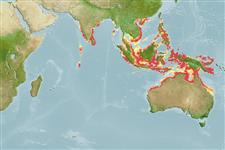>
Eupercaria/misc (Various families in series Eupercaria) >
Haemulidae (Grunts) > Plectorhinchinae
Etymology: Plectorhinchus: Greek, plektos = plaited + Greek, rhyngchos = snout (Ref. 45335).
More on author: Bleeker.
Environment: milieu / climate zone / depth range / distribution range
Sinh thái học
Biển Cùng sống ở rạn san hô; Mức độ sâu 5 - 40 m (Ref. 90102). Tropical; 22°N - 25°S, 72°E - 153°E
Indo-West Pacific: west coast of India; Philippines and Indonesia to Papua New Guinea, south to northern Australia (Ref. 9710).
Bộ gần gũi / Khối lượng (Trọng lượng) / Age
Maturity: Lm ? range ? - ? cm
Max length : 50.0 cm TL con đực/không giới tính; (Ref. 48635)
Các tia vây lưng cứng (tổng cộng) : 12 - 13; Các vây lưng mềm (tổng cộng) : 19 - 22; Tia cứng vây hậu môn: 3; Tia mềm vây hậu môn: 7 - 8. This species is distinguished by the following characters: chin with 6 pores, no median pit; gill rakers on first gill arch 7-9 + 1 + 17-20 = 26-29; Dorsal XII (rarely XIII), 19-22, 3rd-5th spines longest; lips fleshy, moderately swollen with age; scales ctenoid (rough to touch); lateral line tubed scales about 54-60; body depth 2.6-2.9 in SL; caudal fin rounded to slightly emarginate. Colour: brown to yellowish grey with 5 to 9 fairly narrow grey or white longitudinal stripes outlined with dark brown on body and continuing around snout; fins yellow, soft dorsal, caudal, and pectoral fins with darker stripes disappearing with age; eye and lips yellowish; mouth, tongue, and gill rakers scarlet; chin white; juveniles have fins striped and fewer stripes on body (Ref. 47695, 90102).
Occurs on coastal and seaward reefs. Adults on deep, current-prone slopes with rich invertebrate growth; juveniles on sheltered reefs nearby (Ref. 48635). Found singly, in small groups under ledges or large resting aggregations by day, forages for small invertebrates at night (Ref. 9710, 90102). Caught throughout its range; not common. Rarely marketed in India (Ref. 3412). Taken by handline and spear. Marketed fresh, a small quantity is salted (Ref. 47695).
Life cycle and mating behavior
Chín muồi sinh dục | Sự tái sinh sản | Đẻ trứng | Các trứng | Sự sinh sản | Ấu trùng
Oviparous, distinct pairing during breeding (Ref. 205).
McKay, R.J., 1984. Haemulidae. In W. Fischer and G. Bianchi (eds.) FAO species identification sheets for fishery purposes. Western Indian Ocean (Fishing Area 51). Vol. 2. FAO, Rome. pag. var. (Ref. 3412)
IUCN Red List Status (Ref. 130435: Version 2024-1)
Threat to humans
Harmless
Human uses
Các nghề cá: Tính thương mại
Các công cụ
Special reports
Download XML
Các nguồn internet
Estimates based on models
Preferred temperature (Ref.
123201): 27 - 29.3, mean 28.7 °C (based on 1858 cells).
Phylogenetic diversity index (Ref.
82804): PD
50 = 0.5000 [Uniqueness, from 0.5 = low to 2.0 = high].
Bayesian length-weight: a=0.01820 (0.01098 - 0.03017), b=3.01 (2.87 - 3.15), in cm total length, based on LWR estimates for this species & Genus-body shape (Ref.
93245).
Mức dinh dưỡng (Ref.
69278): 4.0 ±0.66 se; based on food items.
Thích nghi nhanh (Ref.
120179): Trung bình, thời gian nhân đôi của chủng quần tối thiểu là 1.4 - 4.4 năm (Preliminary K or Fecundity.).
Fishing Vulnerability (Ref.
59153): Moderate vulnerability (40 of 100).
Nutrients (Ref.
124155): Calcium = 33.7 [12.0, 63.5] mg/100g; Iron = 0.51 [0.27, 0.96] mg/100g; Protein = 19.5 [17.7, 21.3] %; Omega3 = 0.134 [0.073, 0.216] g/100g; Selenium = 30.9 [18.2, 52.3] μg/100g; VitaminA = 81.8 [33.1, 199.7] μg/100g; Zinc = 0.995 [0.688, 1.473] mg/100g (wet weight);
